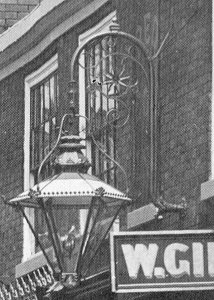|
Many of the local towns were catered for, when an Act of Parliament
was passed on 20th May, 1825 to allow the incorporation of
the Staffordshire Gas Light Company, which supplied gas to Bilston,
Darlaston, Handsworth, Walsall, Wednesbury, and West Bromwich. A large
gas works was built for the purpose at West Bromwich.
During the 19th century gas production methods greatly
improved and many new appliances were developed. In 1824 Tate invented
the telescopic gasometer, which enabled gas works to supply gas at a
fairly steady rate regardless of demand. The gasometers had several
"lifts" or tiers, floating in a bath of water. As gas was pumped in, the
gasometer would rise and then slowly fall as the gas was used. The tiers
initially rose vertically but were later spirally guided. The first
experimental gas cooker was developed by James Sharp in 1826 and in 1855
Pettit and Smith developed the first practical gas fire.
|

A close-up of the lamp above.
|